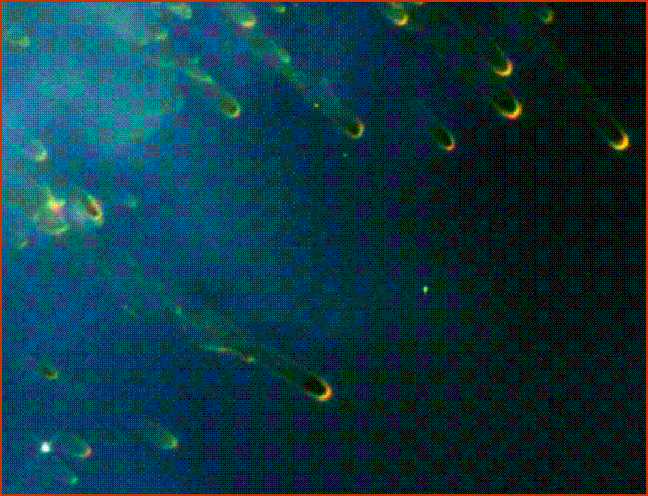
home •
about •
essential guide •
picture of the day •
thunderblogs •
news •
multimedia •
predictions •
products •
get involved •
contact
picture of the day archive subject index
Credit: NASA Hubble Space Telescope
Jan 02, 2007
Cometary KnotsAstronomers have named these features of a planetary nebula "cometary knots" because of their resemblance to giant comets. From an Electric Universe point of view, the resemblance may be more than visual.
As long ago as the 1940¹s, an electrical researcher, Dr. Charles Bruce of England, identified planetary nebulae as stellar electric discharge phenomena.
Although the heads, or comas, of these "comets" are twice the size of our solar system and much dustier than our comets, their electrodynamics is essentially the same. The coma of a solar system comet is generated by the difference in electrical potential between the nucleus and the surrounding plasma. A charged body placed in plasma forms a cocoon around itself, called a Langmuir sheath or plasma sheath. The cocoon isolates the charge on the body from the surrounding plasma. At the sheath boundary, two layers of charge, called a |"double layer," take most of the electrical stress. If the electrical stress is high enough the plasma sheath may glow.
The changing electrical stress on a comet is due to its highly elliptical orbit. The Sun has a weak radial electrical field. A comet spends most of its time far from the Sun and becomes adjusted to the voltage there. As it zips in for a quick fly-by of the sun, the voltage and charge density of the solar plasma changes rapidly, generating increasing electrical stress on the comet. When the electrical stress is high enough, the comet¹s plasma sheath lights up to form the classic cometary spectacle. The comet nucleus begins discharging and the resulting cathode jets sweep back to form a tail that is "blown" in a direction aligned with the Sun¹s electric field.
The same thing would happen to an object of any size on a cometary orbit through the Sun's electric field. If the Earth, which is a charged body, were on a cometary orbit, its magnetosphere would glow. Similarly, the objects forming the cometary knots of the Helix Nebula are responding to the strong electric field centered on the star outside the picture at bottom right.
_______________________
Please check out Professor Don Scott's new book The Electric Sky.
NOTE TO READERS: Wallace Thornhill, David Talbott, and Anthony Peratt will share the stage with other investigators of planetary catastrophe at the British Society for Interdisciplinary Studies “Conference 2007” August 31-September 2. GET INFO
![]()
home •
thunderblogs •
forum •
picture of the day •
resources •
team •
updates •
contact us
EXECUTIVE EDITORS:
David Talbott, Wallace Thornhill
MANAGING EDITORS:
Steve Smith, Mel Acheson
CONTRIBUTING EDITORS: Michael Armstrong, Dwardu Cardona,
Ev Cochrane,
C.J. Ransom, Don Scott, Rens van der Sluijs, Ian Tresman
WEBMASTER: Brian Talbott
Copyright 2007: thunderbolts.info
